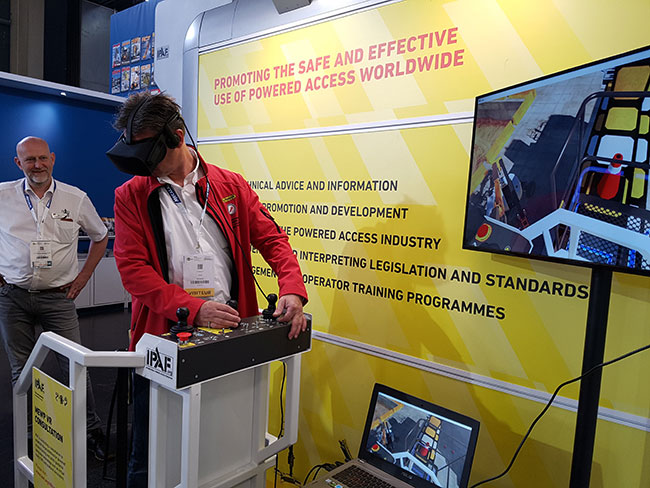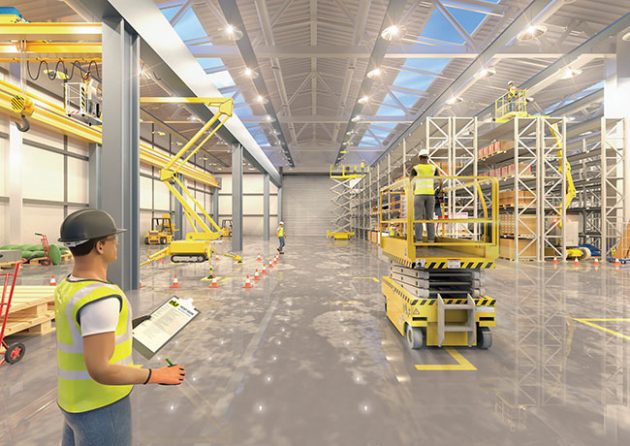
Close to reality – VR gains acceptance as a lift training solution
By International Powered Access Federation
Associations Features Tech tips aerial augmented canada ipaf reality rental scissor training virtual xrVirtual reality aerial training gains acceptance.
 Virtual reality training simulators immerse the user in a 360-degree simulation of an imaginary workspace. They are getting so realistic that operators have been known to grab for a harness.
Virtual reality training simulators immerse the user in a 360-degree simulation of an imaginary workspace. They are getting so realistic that operators have been known to grab for a harness. Technologies including virtual reality and mobile elevating work platform simulators are already enhancing operator training and familiarization and could also offer benefits to those learning to inspect and maintain machines.
Although not likely to completely replace initial MEWP operator practical testing in the foreseeable future, the International Powered Access Federation foresees a future in which advanced operators, or experienced operators looking to retrain after the term of their operator training with frequent equipment use, could be assessed and evaluated using approved simulators as opposed to actual machines at height. Likewise, operators can get used to operating different brands of equipment or carry out specific complicated tasks or work in challenging environments to demonstrate competency and practice in hazardous scenarios risk-free without leaving the ground.
Virtual reality (VR) visually takes the user out of their real-world environment and into a virtual environment, typically using a headset for viewing coupled with handheld controllers to navigate the virtual space. Augmented reality (AR) overlays digital objects (information, graphics, sounds) on the real world, allowing the user to experience the relationship between digital and physical worlds. Together, we call them Extended Reality (XR).
Many applications
XR technology aids memory retention and recollection ability, compared to viewing videos or text-based materials. A 1991 study found that memory is anchored and made stronger when there is increased multi-sensory and emotional input. This was again demonstrated in a recent study, in which participants were presented with either a 360-degree VR video or a two-dimensional video of a motorcycle ride, followed 48 hours later by a memory test. The results showed that the VR group performed twice as well as the video group in the memory recollection test. IPAF is satisfied these studies show there are substantial reasons to use XR to improve training.
VR simulators can currently prepare candidates effectively for practical testing. It is not inconceivable that, as they develop, they might replace practical testing in the future. It is certain that AR would enhance pre-use inspection of MEWPs considerably. This could enrich theory and practical training elements. Interactive 360-degree video can contextualise a huge range of hazards associated with MEWP use. These would be a cost-effective and high-benefit change that could be implemented relatively quickly. VR simulators could play a major role in refresher training, to test the ongoing competency and skill of an operator.
The use of a MEWP simulator would enable an operator to experience high-risk scenarios and would be a suitable alternative or complement to a training course. If simulators can challenge and test an operator and provide realistic physical input, realistic physical feedback and fulfill all the objectives of the Powered Access License Plus practical test, it would be a commercially viable option for IPAF-approved training centres to offer this option. This could provide an opportunity for training centres that do not currently offer any advanced MEWP operator training to begin doing so.
XR may have uses for incident response. Using VR and other XR technology, operators would learn how to respond to unexpected scenarios, for example, subsidence, an overhead collision, or a situation requiring a basket-to-basket rescue.

Using Building Information Modelling (BIM) software, it is possible to load an accurate model of a real building into the XR simulator. This allows operators to practice before actually going to the jobsite.
How it might work
Ethan, a fitter, has little knowledge of powered access or MEWPs and will be required to use them as part of his new construction job at a steel erector firm. As part of his training, he must obtain a valid PAL card. He visits the IPAF website to learn more about training, what type of MEWP he can be trained on and where his nearest training centre is.
As a novice operator, Ethan decides that the virtual classroom will be his best option and uses his VR glasses to enter the training environment from home. A virtual IPAF instructor is on hand to guide Ethan through the training and answer any questions that he has as he goes through the course, which takes him 3.5 hours. Ethan’s retinas are scanned to ensure he is who he says he is, and to verify his identity throughout. Ethan passes the theory test and is then offered a nearby place (perhaps a rental store?) where he can use an IPAF-certified simulator to undertake his practical training and testing. Ethan passes the VR course that accurately models the equipment he will use and is awarded a virtual PAL card that corresponds to his iris. On the construction job site, before Ethan can use a real MEWP, Ethan’s iris is scanned by the machine and it verifies that he is qualified to operate it.
Some weeks later, Ethan required to undertake a job that will involve working near overhead structures and negotiating small openings, so he decides to take IPAF’s advanced operator course, PAL Plus, to improve his skills. Ethan registers for this training online and visits the same facility where he undertook his initial training.
The next time Ethan uses a machine it recognises that he now has his PAL Plus and reminds him that he should be careful when moving backwards and down, which he is. He completes his work in the real building without incident and decides that next time he has a complex job coming up he will visit the VR facility to familiarise himself with the building and practise the manoeuvres in a safe environment.
Four years and six months after his initial test, Ethan receives a reminder that his PAL card will expire shortly and is asked to return to the VR facility for re-testing. Ethan has by now logged hundreds of hours of machine use on a cloud-based database, and is quite an expert. He selects “test only,” passes with flying colours and is back out with a renewed five-year virtual PAL card within the hour.
Going forward
MEWP simulators are now so advanced that operators have been known to reach for an imaginary harness while operating XR simulators. IPAF has benefitted from being able to showcase specific manufacturers’ simulator platforms, including those developed by Canadian firm Serious Labs (an IPAF member) at events around the globe. This has allowed IPAF to gauge industry feedback and to develop new ways to integrate the technology into its training.
After extgensive consultation, IPAF has found there are substantial reasons to use XR to improve training. No prior technology has shown as much potential to revolutionize the way IPAF provides candidates with the knowledge and skills to stay safe.
Print this page
Leave a Reply